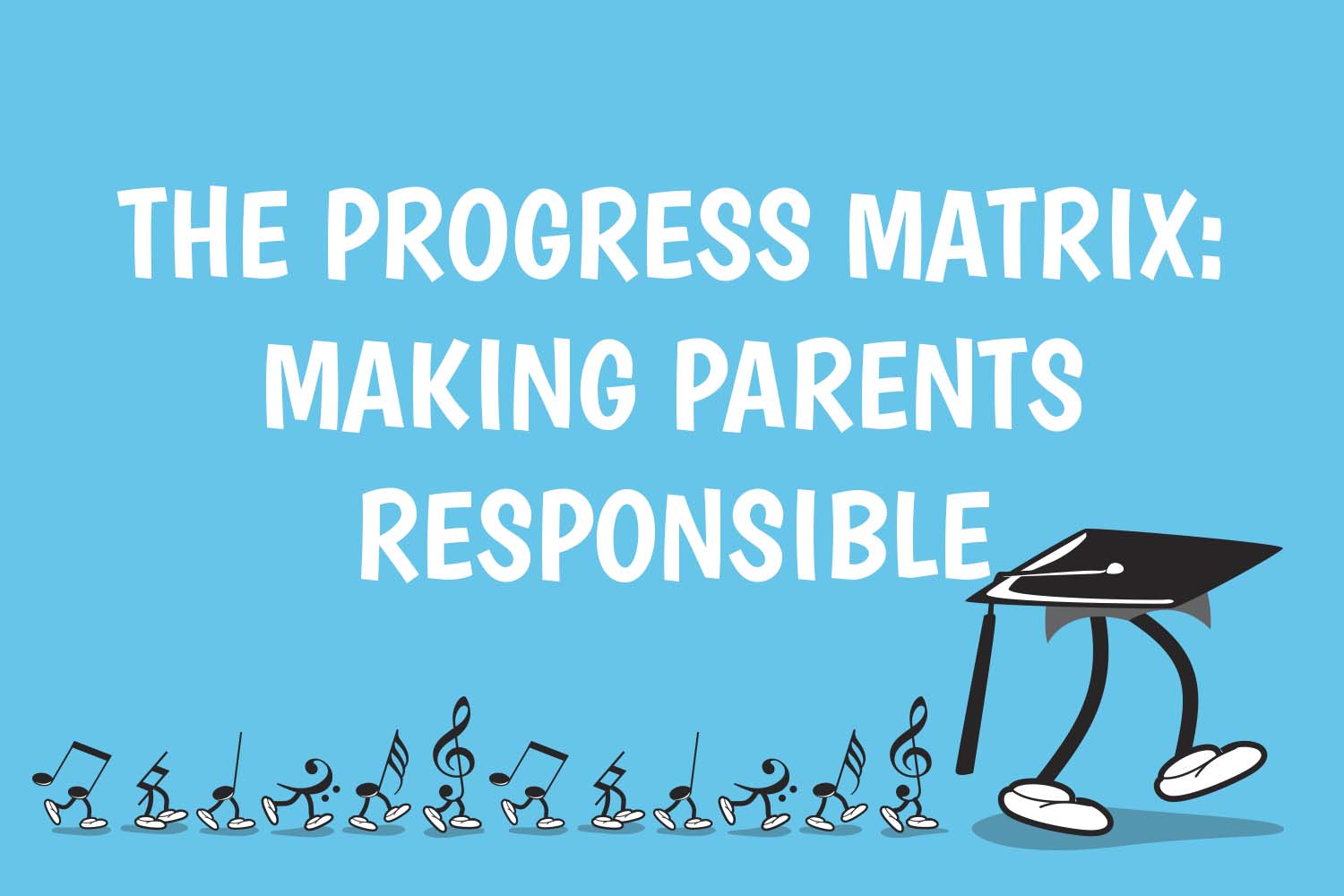The Progress Matrix: Making Parents Responsible

I am a member of several piano teacher groups on Facebook. To me it seems that the conversation that comes up most often is on how to retain students who don’t practice. There are rants about the schedules that don’t permit enough practice time, the parents who expect everything to be fun and easy, the arguing between parent and student at home (and sometimes between student and teacher in the lesson!) and the expectations from all that are rarely met. Some teachers don’t mind if their students don’t practice, others expel them from their studio immediately. Some parents are realistic and supportive, others demand ridiculous results without much investment.
This year I have had the opportunity to attend several conferences and make a number of new piano teacher friends and to learn from colleagues. I have put a great deal of energy into my teaching and a lot of thought into how to motivate students to practice. But I think what I am going to focus on for next year is not practice, but progress.
There are two ways to ensure progress at home. The first, of course, is practice. The second is the level of parental support. Many parents don’t realise the role they play in their child’s progress. They think they can simply drop their child off for 30 minutes a week, and somehow the teacher will transform their child into a competent pianist. They will typically not ask any questions at all about how much to practice or how often, and will assume that if the child truly wants to learn then surely they will motivate themselves to practice (which, as we know, rarely happens).
I am proposing two simple categories for practice:
- Regular practice1 (let’s say 4 or more times per week)
- Infrequent/no practice (let’s say 3 or fewer times per week)
And two simple categories for parental support
- Supportive2 (sitting with child/helping practice to be efficient)
- Unsupportive (never overseeing any practice)
Now we can use these two components, practice and support, to create a matrix that will determine the progress of the child.
|
|
Practice | Not much or No practice |
| Support | 1
Fastest possible progress |
2
Slow progress |
| Not much or No support | 3
Reasonable progress (unusual) |
4
No progress |
Here’s the thing: we should show this matrix to the parent, and ask them:
Which quadrant do you want to be in?
Quadrant 1: Best Possible Progress
The child who practices regularly and has a parent either sitting with them or at least listening, encouraging and overseeing what is being done will progress quickly. The regular practice ensures fast learning and that muscle memory is retained. The supervision minimises distractions during practice and ensures that good technical habits are being formed. These students simply rip through the repertoire and can easily be on an exam track if they so wish. Über-supportive parents can sometimes err on the side of tiger parent which is stressful for the teacher, but at least the practice is being done.
Quadrant 2: Slow Progress
Children who have supportive parents but who don’t practice much are typically the ones who live overscheduled lives. The parents may oversee practice and wish their child to succeed, but unfortunately they are doing this for several different activities in the child’s week, leaving them little or no time to actually achieve anything. The parents’ desire for results but lack of implementation of a practice routine leads to much pressure being put on the teacher to achieve unrealistic results with the student.
Occasionally, there are students who seem to manage on not much practice. As they are well supported, their practice is so efficient that they do in fact progress – just not as quickly as they could. Parents need to accept that if they are in this quadrant, progress has the potential to be much faster if there were more opportunities to practice.
Quadrant 3: Reasonable Progress
This is the least common of the four quadrants. The child who willingly practices regularly and efficiently without any support is rare. Most often, students in this situation end up ‘playing’ more than they are practising, and therefore don’t address the nitty-gritty issues as well as they could if they had support. Progress will be at a reasonable speed, depending on how much the student is willing to adhere to all the instructions given by the teacher during the lesson.
Quadrant 4: No Progress
And here we are at the crux of the matter: if there is no practice, and no support, there will be little or no progress. Even if there are 1 or 2 practices happening week, with no supervision this practice is fairly useless, as it is often done with the wrong technique or without focusing on problem areas.
The parents in this quadrant are often the ones who say ‘Oh, we’re just doing it for fun’. But week after week, the teacher will be going over the same things. No-one will be having any fun: the teacher because there’s nothing to build on; the student because they can’t actually play; the parent because they can’t see any progress and are wasting their money.
So, in conclusion: I have decided that I will print this progress matrix, laminate it and bring it out at the very first interview with a new student and parent. I am intrigued as to the reaction I will get (although, having said that, I can usually weed out the Quadrant 4 parents over the phone, before it ever gets to an interview stage). I will also make sure, the next time a parent of one of my current students tells me what they want their child to achieve that year, that I whip out the matrix and ask them which one they’re currently in. I’m going to make the parent take the responsibility for their child’s rate of progress. If you would a copy of this matrix for your studio, here’s the link to a printable version.
My hope is that by focusing on the progress matrix there will be a shift in the parent’s attitude. They will hopefully realise that paying for a weekly piano lesson does not in itself ensure that any skill will develop; what happens at home in between the lessons is the crucial factor.
I’d love to know your thoughts on this! Please comment. And for a more detailed description of progress, read Part 2.
- It’s pretty difficult to define regular practice. Every teacher has different expectations. But at least with a minimum of 4, they are practising on more days than they are not practising.
- I am not including the over-supportive-and-in-fact-too-pushy ‘tiger parents’ in any of these categories. They really are in a category of their own as their ‘support’ is too often negative and unhelpful. That is a whole other blog post.

Oh my goodness.. we really are leading parallel lives =”what happens at home” is the big issue along with the lesson. Thanks for the quadrant image–stealing it!
Thank you Sam. I like your concept of “progress”. Our son is 7 and I’ve been happy to see “progress” – even if it’s squarely in the orange quadrant! I do sit with him to practice and call it a “music lesson”. It helps that I can also play the piano. Another focus is to ensure he’s enjoying his music, and this is where group lessons like AMS are great!
Fantastic that you’re able to sit with him Robin – makes practice so much more enjoyable and fruitful!
Thanks Samantha for writing this and sharing the progress matrix! It is very true that the parent needs to take responsibility for their child’s progress and the matrix explains it all.
Thinking back to my piano lessons when I was young, I remember my mum sitting next to me at the lessons and every day of practice by patiently guiding, singing along, encouraging me when I wouldn’t sing and timetabling practice every day due to how costly the lessons were. She knew that she had to observe me to avoid wasting time and money but good things have happened because of this. I pursued music and my brother can pick up tunes he likes by ear and plays without looking up sheet music.
I don’t understand parents who sit in the lessons but are on their phones when I allow them to sit in the lesson to observe what’s going on in lessons and how they can help their children practice. I can’t think of any reason why parents don’t observe practice except that they are too busy (which I get), cannot be bothered and or don’t want to be involved in long and sometimes frustrating process of learning (who said learning was easy?).
I love the chart and I will definitely use this in future interviews (and at lessons if parents ask how their child is progressing).
Thanks for this wonderful response! What fantastic support you had when you were younger. Regarding parents being on their phones – do they do this in spite of you asking them to observe? Or is it more that you are assuming they will observe but they don’t? If it’s the former, try asking them to be the ‘scribe’ during lessons so that you can ‘get through more in the lesson’ – this at least appeals to their sense of getting value for money!
Hi Sam, Thanks for all your work over the years. I use your theory books regularly and look forward to using your other publications also.
I have written an eBook called “A Parent’s Guide to Beating the Practise Blues.” It contains real life stories and pictures of families who are hands on with their kids and what they do to achieve peace in the home when it comes to practise. If you are interested in the 4 Tools these parents have discovered the eBook link is here. These tools are really bridges to get the parents and children together, to at least get the practise started. I’d love to get your feedback on it. http://beacon.by/music-matters/type-master-1-5
Thank you Heather, I will check it out!
Thanks Sam, I regards to parents in lessons, I’m all for it but I feel it is my responsibility to create the WIFM for them. My experience is that if parents are internet surfing during lessons, then they haven’t been engaged right from the moment they come in the door. “What’s In It For Me” is a new generation requirement. Engage and support the parent at specific times during the lesson and they won’t want to miss a word. I have a few specific tools I use for this purpose.
Pingback: Friday Finds #97 | Piano Pantry